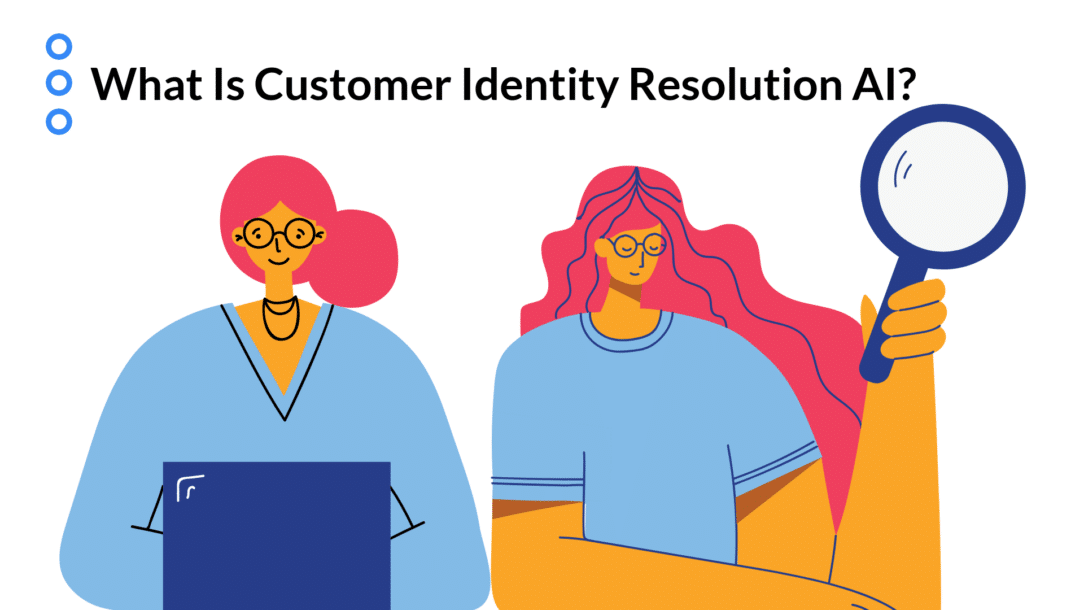Building a 360-degree view of the customer profile is critical for providing a personalized customer experience and supporting their data privacy. Inaccurate consumer profiles, disjointed interactions, and missed opportunities can hinder your brand’s growth. That’s where a customer identity resolution AI eliminates incomplete and duplicate data and connects consumer identifiers across channels and devices.
By combining diverse data sets and delivering a truly comprehensive 360-degree view, AI-powered customer ID resolution enables you to make informed decisions.
In this guide, we briefly discuss customer identity resolution, its importance, and how it works.
What is Customer Identity Resolution AI? Probabilistic Vs. Deterministic ID Resolution
Customer identity resolution AI accurately and consistently identifies individual consumers across various touchpoints and channels with AI-powered tools. These tools collect data from multiple sources to create a unified and comprehensive customer profile for marketing and advertising.
The basic steps involve:
- Consolidating user data across different channels
- Adjoining identifiers across all devices and channels
- Building a comprehensive and unified 360-degree consumer profile
- Solving customer privacy and compliance issues
Building a consumer ID is like assembling a puzzle with pieces scattered across multiple tables. You must find all the pieces that fit together perfectly to reveal the complete picture of each customer. Removing duplicate or incomplete profiles presents one of the key challenges.
For example, when a consumer interacts with your brand via a website, social media, and email sign-ups, separate profiles form without a customer resolution ID. This results in fragmented data about the customer journey.
With an AI-powered customer ID resolution tool, the system identifies, merges, and streamlines these profiles into a comprehensive customer profile. Managing ID ensures more effective multichannel engagement, improves targeting and creative tactics, and enhances measurement accuracy.
Probabilistic Vs. Deterministic Identity Resolution for Customer Data
Probabilistic and deterministic identity resolution are the two methods used to create unified consumer profiles. You might wonder which method best resolves cross-channel data. Let’s explore both approaches.
- Probabilistic ID resolution uses predictive algorithms to match user behaviors to their profile.
- Deterministic modeling uses first-party data to link user engagement to their profile. This method works when common personally identifiable information (PII) is shared.
Since predictive algorithms in probabilistic modeling are not 100% accurate, this approach always carries a margin of error. Use this approach for analytics cases where ballpark numbers suffice and the risk of ID resolution errors remains low. Avoid probabilistic ID resolution in critical customer experiences to prevent poor engagement and wasted budget.
On the other hand, deterministic ID resolution delivers accuracy and provides a 1:1 personalized experience for customers.
How Customer Identity Resolution Works to Identify, Merge, and Match Data Sources
AI-powered customer identity resolution begins by collecting consumer data from various channels and touchpoints, such as online interactions and offline transactions.
The system then standardizes the data by identifying and correcting errors, removing duplicates, and addressing formatting issues. Additional information from external sources enhances accuracy. Advanced algorithms then use the refined customer data to match and link consumer records based on common identifiers.
Different matching techniques link these records using identifiers like email addresses or phone numbers, creating a comprehensive buyer profile. Choose the following matching techniques based on available data sets, desired accuracy, and the unique customer ID resolution journey.
Deterministic Approach
As mentioned earlier, deterministic matching links a consumer’s digital interactions using identifiers like email addresses or phone numbers. This approach ensures accuracy when precise clues exist. For example, when a buyer signs up for a loyalty program using the same email address across interactions, the system consolidates their data to form a clear profile.
Probabilistic Modeling
The probabilistic approach weaves patterns from multiple data points but lacks complete accuracy. It pieces together consumer records without exact identifiers. For example, two customers with similar browsing and purchasing histories may be mistakenly grouped under one profile.
Machine Learning
Machine learning (ML) algorithms analyze data patterns and consumer behaviors, adapting to evolving customer interactions to improve accuracy over time.
A machine learning model studies users’ past interactions and preferences, delivering personalized recommendations and offers.
Graph Database
Graph databases swiftly analyze customer connections for accurate matching. They store and manage relationships between data points. For example, a social media platform buzzing with user activity links profiles based on connections, interests, and interactions, offering personalized content recommendations. By integrating data from different sources, CRM systems enhance customer journey insights, improving relationships and ID resolution.
This integration allows brands to personalize interactions, create compelling marketing campaigns, and provide engaging customer experiences from a central CRM system.
Why Do Marketers Need These Platforms? Key Reasons/Benefits
Customers interact with brands through various devices, including computers, mobile phones, Smart TVs, gaming consoles, VR headsets, and home assistants like Google Nest or Amazon Alexa. As these interactions increase, marketers must understand both online and offline behaviors to refine marketing strategies. Each visit attributes a different identifier to the individual.
Customer identity resolution AI platforms connect different customer touchpoints, providing a holistic understanding of consumer preferences and behaviors. By integrating data from multiple sources, these platforms unlock insights that elevate marketing strategies.
Customer identity resolution enables brands to personalize marketing efforts based on past customer interactions, such as previous purchases, browsing history, and style preferences. As a result, brands can offer tailored product recommendations, leading to higher conversion rates and increased customer satisfaction.
Summary
Customer identity resolution AI collects customer data from various channels and touchpoints to map a consumer’s journey with a brand. AI-powered customer ID resolution then uses preferences and styles to create unified customer profiles and offer personalized recommendations.
This process increases conversion rates while improving customer service and satisfaction.
Enhance Social Media Engagement with AI-Powered Chatbots
Want to boost engagement and deliver hyper-personalized experiences with chatbots on social media? AI-powered customer identity resolution helps unify data for better targeting and meaningful interactions. Start optimizing your chatbot strategy today!
Related Posts



